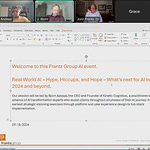Vectors, vectors, everywhere!
Have you heard about Vector Databases, Vector Embeddings, or Large Language Models (LLMs) and wondered how they actually work?
At their heart lies a fundamental concept: teaching computers to understand and process human language. This video dives into how computers take words and turn them into something they can truly manipulate – numbers. The challenge is that computers cannot directly grasp the meaning of words the way humans do; they require data in a numerical format. A collection of numbers representing a word or concept is called a vector. You'll learn why simple initial attempts, like one-hot encoding, fall short. While it converts words into numbers, this method creates very large, inefficient vectors that are mostly zeros and, crucially, fail to capture the real-world relationships between words. For instance, using one-hot encoding, "dog" and "wolf" would appear no more similar than "dog" and "telephone".
The Magic of Embeddings
The video then explores a more effective approach using features to create denser, richer vectors that begin to reflect characteristics and meaning. This leads to the powerful technique of embedding. Embedding takes these numerical vectors and places them into a multi-dimensional space. The key idea here is that similar things are positioned close to each other within this space, allowing the vectors to capture context and semantic value. Discover how this numerical representation makes it possible for mathematical operations to reveal relationships between concepts. Using illustrative examples, the video demonstrates how simple vector math can show how relationships like "man is to woman as king is to queen" are represented by how these concepts are located relative to each other in the embedding space.
While real-world embedding models are incredibly complex, utilizing hundreds or even thousands of abstract dimensions (like the 1,536 dimensions mentioned for one model), the video offers a way to think about this high-dimensional space. You'll see how even in this complexity, patterns of similar numerical values across dimensions can indicate the relationships computers perceive between concepts, sometimes visible in visualizations.
Understanding how words are transformed into these numerical vectors and embedded in space is foundational to grasping the technology that powers much of modern AI's ability to process and make sense of language.
By watching, you'll gain insight into: •
The core reason computers need to convert words into numbers (vectorization).
The limitations of basic methods like one-hot encoding.
How embedding creates a space where proximity means similarity.
How vector math can reveal semantic relationships.
A glimpse into the abstract nature and scale of real-world embedding models.
If you're curious about the foundational mechanics behind AI language processing and want to understand terms like vectorization and embedding, this explanation provides a clear starting point.
P.S. Here’s what real-life embeddings look like when using the OpenAI "text-embedding-3-small" model (1,536 dimensions).
Here are supplemental files you can use for interactively exploring these feature vectors:



